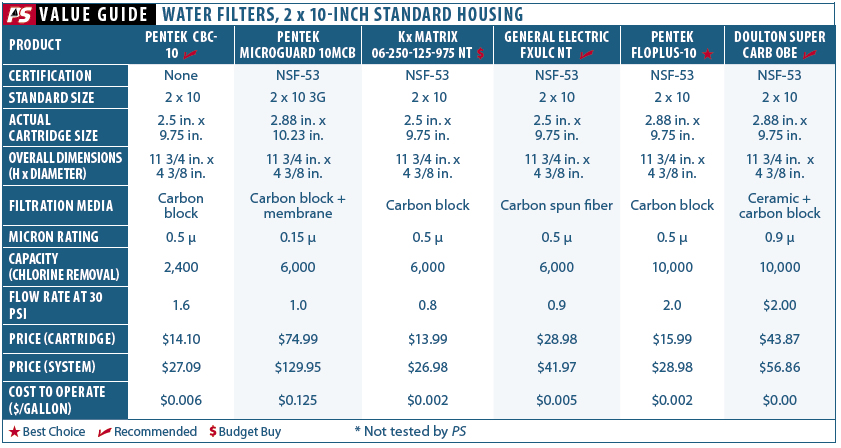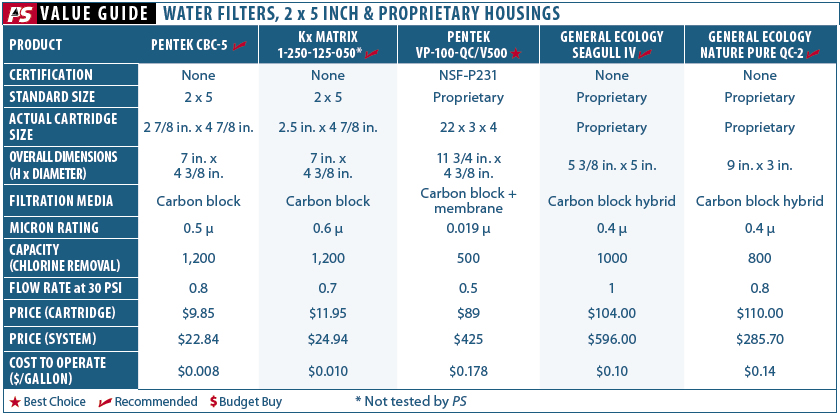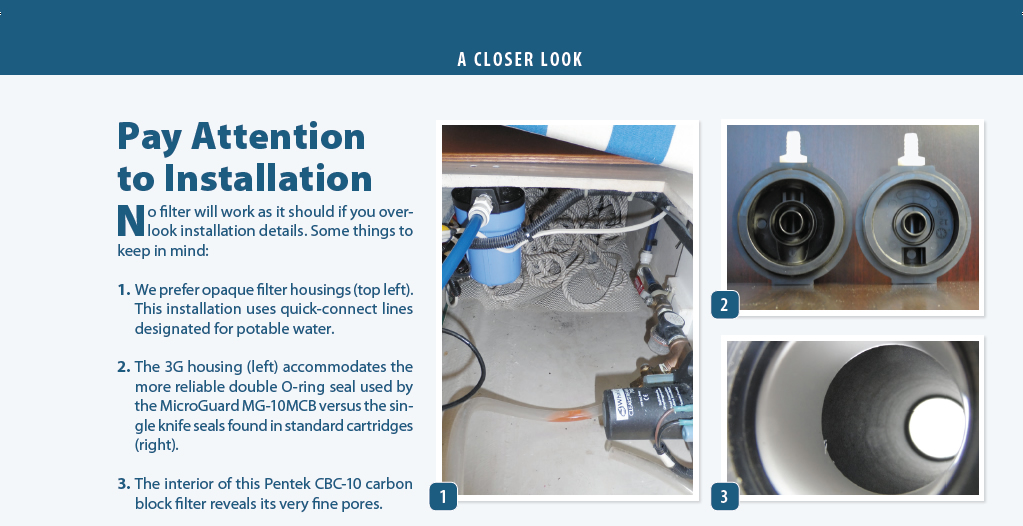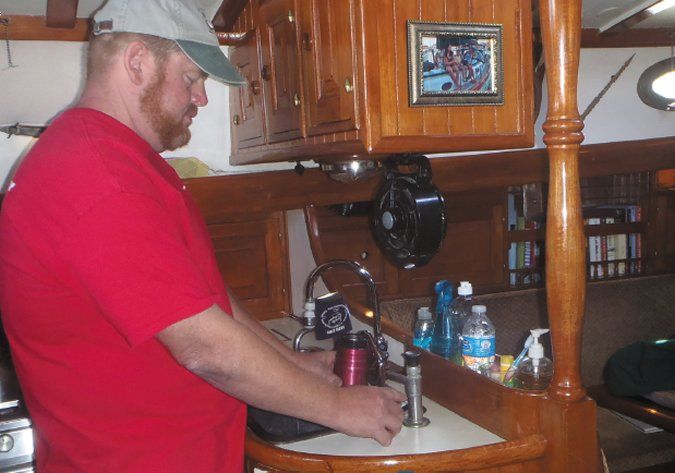
If youve followed the first two installments in this three-part series on ensuring safe, fresh-tasting drinking water onboard, youve cleaned your freshwater tank, pre-filtered all water going into the tank, screened the vent, and disinfected the contents. Now that the water has sat in the tank, its time for one more filtration process; this time, focusing on improving taste and eliminating micro-organisms.
Our goals are modest: remove chlorine residuals, cysts, and most bacteria with inexpensive and simple 0.5-micron, carbon-block filters. Pathogenic viruses are a tiny risk in most developed areas, and chlorine treatment should eliminate them.
The sailor headed outside the U.S. and to areas where the quality of tap water is less certain will set higher goals. He will consider adding a filter certified by the National Sanitation Foundation (NSF) to remove cysts, bacteria, and even viruses. Certified filters cost more, but bring peace of mind.
All of the filters we discuss here can be used to filter water from a reverse osmosis (RO) watermaker. (See PS February 2013 online for our most recent watermaker test.) Why filter watermaker water? Although the reverse-osmosis process eliminates most microorganisms, the chance of internal leakage prevents them from being NSF rated as true microbial barriers without additional treatment.
Filter Media
In the previous article on pre-filtration of tap water (see PS June 2015 online), we discussed filter media-pleated elements, granulated activated carbon (GAC), and GAC with kinetic degradation fluxion (KDF). (See the online version of this article for links to that discussion.) Assuming the tank has been well maintained, the water is ready for final filtration. Granulated carbon filtration is not appropriate filtration at the tap; the canisters shed fine particles, and in the absence of consistent chlorination-something you have at home but not on the boat-they grow bacteria. A fine-pleated element is no help for final filtration either; weve already removed everything that it filters out-sediment and clumps.
Carbon Block
Activated carbon is powdered, then combined with additional filtration aids, and with the addition of a binding agent, it is compressed into a solid tube. The result is very fine filtration, ranging from 5 microns to 0.5 microns. A pressurized water system is generally required, but 0.5-micron filters will positively block protozoa and cysts, including cryptosporidium parasites, and provide substantial reductions in bacteria and viruses.
Carbon Block Plus Membrane
Pentek revolutionized this niche by combining a carbon-block filter with a membrane microbiological barrier located in the core, all within a cartridge that fits inexpensive, standard filter housings. To improve bacteria and virus capture, the company has upgraded from a single knife-edge seal (standard cartridges) to a double O-ring seal. This required a slight modification of the standard housing to a version that Pentek calls 3G. The new housing is backward compatible with older cartridges.
Structured Matrix
General Ecology has produced structured matrix filters under the Seagull brand for over 40 years, earning a solid reputation worldwide. Simple and maintenance free, structured matrix filters are closely related to carbon-block filters.
The maker claims structured matrix removes viruses, but it is not NSF certified for this purpose. Its removal of viruses is somewhat dependent on adsorption mechanism, and there is some risk of bleed through after the rated life is exceeded. This is not a problem if the unit is replaced on a regular schedule.
In theory, positive capture of viruses requires incredibly small pores, as small as 0.003 microns absolute, requiring construction similar to a reverse-osmosis unit. However, one filter in this review has a pore size of 0.019 microns, and is certified to NSF-P231, suggesting that adsorption mechanisms are stable and effective for removing virus and that some NSF-53-certified filters, like the Seagull filters, might also help keep out viruses.
Pitcher Filters
None of the popular pitcher filters are certified to remove cysts or perform fine filtration. These filters can help with taste, but offer only an illusion of safety. In our opinion, these filters arent worth the counterspace they will occupy on the boat.
What We Tested
We focused our testing on carbon-block filters, since these offered the best combination of affordable price, ease of installation, and effectiveness. We previously tested the more sophisticated Seagull structured matrix filter. (See PS October 2013 online.) We also reported on some NSF-certified units we did not physically test; NSF testing is independent and more rigorous than anything we could perform, and we have confidence in the numbers on NSF-certified systems.
How We Tested
We began our evaluation by installing a carbon-block filter (Pentek CBC-5) on a test boat. Because our mounting space was tight, we chose the smallest standard cartridge size (nominal 2-by-5 inches). Realizing there was sufficient space for a larger size, we substituted a 2-by-10 housing to provide faster water flow. With the NSF-certified products, we measured flow rates and chlorine removal efficiency, to confirm what they reported. We used a combination of laboratory equipment and aquarium test strips during our testing; the test strips never conflicted with our lab results.
Field Observations
Filters designed to eliminate chlorine taste are rated by the total number of gallons they can remove, based on standard 2 parts per million (ppm) free chlorine. If you can taste chlorine or detect it with a test tape, the filter may be due for a change. However, carbon-block filters are very efficient at removing chlorine; the chlorine reacts with the carbon and organic materials adsorbed onto the filter, slowly burning it away. In fact, low levels of chlorine extend filter life by burning off minor organic contaminants, beyond 1,000 gallons this process increases pore size, reducing filtration efficiency and increasing the microorganism pass-through; do not over-chlorinate.
Carbon block filters do slow the water flow significantly, but never below usable rates. With the 0.5-micron, 2-by-5 block (Pentek CBC-5, the finest tested), the rate was like a refrigerator-door water dispenser-noticeably slow when filling pots-but after upgrading to the higher volume 2-by-10 FloPlus 10, we did not notice any reduction in flow.
After installing each cartridge, we used volunteers for blind tasting. We drew a sample from the tap, a sample of bottled water, and a sample of local tap water (unfiltered). We used Deer Park as the bottled water standard after determining by analysis that the mineral content was very similar to local tap water.
Installation
While it can be desirable to filter the whole boats tank water, many people filter only the tap used for drinking. If you choose to filter only the cold water in a single tap, there is some risk of contamination with unfiltered hot water. Most of the units we reviewed are relatively low flow (1.5 to 2 gallons per minute) and are suitable only for a single tap. However, the Doulton Rio-2000 (9.8 gallons per minute) is suitable for whole-boat filtration. Keep in mind, that as long as the tank is chlorinated, risks in the shower and at other taps are trivial. Do use the hot water regularly, even if not heated, to pull fresh chlorinated water through all of the pipes to reduce biological growth in the lines.
Foot pumps might affect performance. We tested only one filter-the Pentek FloPlus-10-using a Whale Gusher foot pump, and found that it took about 30 seconds of slow but steady pumping to fill a glass. A cruiser with a Seagull IV X-1F reported a similar effort. These filters work much better on pressure water systems.
Housings
We focused our test on universal cartridge housings. We like the flexibility, worldwide availability, and economy. We see no upside in proprietary systems, which are vulnerable to design changes and pricing vagaries, and offer few options for refills. Specifically, we like the Pentek 3G Slimline 10-inch housing for on-board applications; it takes the greatest variety of elements and is very economical. We see no benefit to clear housings, especially for dockside use; they are more vulnerable to damage from the suns ultraviolet light and encourage algae growth.
We like housings with half-inch NPT fittings. They adapt to a variety of plumbing types. We don’t like pressure-relief fittings or pressure gauges; they add failure points and complicate installation. We have used these housings in industrial settings for many years and have confidence in their durability. Cost is $11 to $45, depending on features.
Cartridge Filters
Except where otherwise noted, all products were tested in Pentek housings. The 2-by-5 housing was a Pentek half-inch FPT Slimline housing (Model 35-125F, part number 158203, $13). The 2-by-10 housing was a Pentek half-inch FPT 3G (Model 35-125F, part number 158648, $12). Both are NSF-42 certified and rated for pressures up to 120 pounds per square-inch.
KX Matrikx
Rated to 0.6 microns, the KX Matrikx (1-250-125-050) filter is a good example of a 2-by-5, carbon-block filter. The manufacturer is well-respected in the field of filtration, and the $12 filter prices are reasonable.
Bottom line: Just a notch below our favorites in this category from Pentek, the KX Matrikx filter is Recommended.

Pentek CBC-5
Though its not rated to NSF-53 standard, Penteks CBC-5, a 0.5-micron, carbon-block cartridge filter, should stop cysts and a good portion of bacteria. It did slow the water flow appreciably, down to 0.7 gallons per minute at 35 pounds per square inch, about the same as a fridge tap. Increasing the housing to the 2-by-10 version will give you all the flow you need for a galley tap. For this reason, and because 2-by-10 cartridges are available more places and in more types, we recommend a 10-inch housing, if you have the space. It had all the life we need, excellent smell and taste improvement. It is priced at about $10.
Bottom line: This is all the typical U.S. coastal sailor needs while he is filling with safe water. Recommended for smaller boats.

PENTEK CBC-10
The Pentek CBC-10 carbon-block cartridge filter is the big brother of the CBC-5 we installed on the test boat. It delivers twice the flow (1.5 gallons per minute at 35 pounds per square inch). Several cruisers we know prefer this filter. Prices run about $14.
Bottom line: Recommended. A good choice for bigger boats that don’t need an NSF-53 filter.
NSF-53 Certified Filters
Independently verified to remove microbial cysts from water, the NSF-53 certified filters will also remove nearly all bacteria and viruses, but they are not certified for this purpose. Except as otherwise noted, all tested NSF-53 filters were in Pentek G3 housings, as described above.
Doulton Sterisyl Super Carb
This filter by Doulton Ceramic Filter Systems was the only one we found that was designed to be cleaned and reused. It is very popular in England. According to the full-time cruisers we spoke with, the Doulton Sterisyl filters can last up to two years with occasional cleaning. Prices run about $44.
Bottom line: Recommended. A good pick for the year-round sailor; carbon-block filters (replaced annually) makes more sense for seasonal sailors.
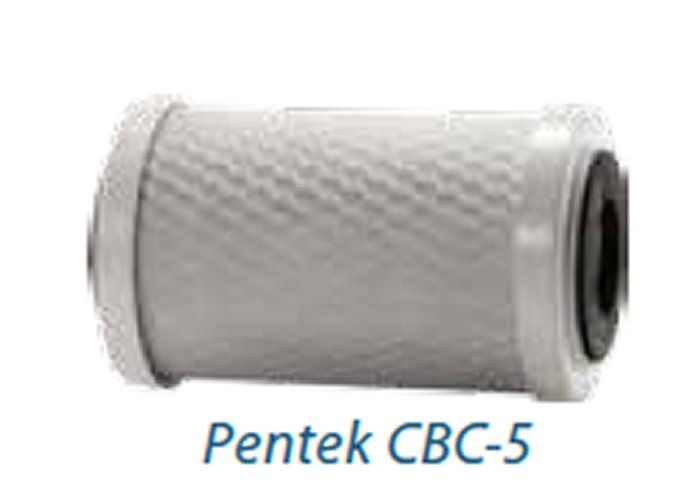
KX Matrikx
The inexpensive KX Matrikx 06-250-125-975 provides all the protection a U.S. sailor will need. The flow rate is a bit slower than other filters (0.8 gpm), but its adequate for a point-of-use device. Price is about $14.
Bottom line: This 2 x 10 filter is our Budget Buy among filters that meet the NSF-53 standard.


Pentek FloPlus-10
The FloPlus-10 is our favorite all-around choice among NSF-53 filters. It costs more than others, but we liked the combination of high flow-rate, acceptable clogging resistance, a fair price, and an NSF-53 rating. Filters cost around $16 each.
Bottom line: This is our Best Choice in the NSF-53 category, and our Best Choice overall for U.S. sailors.
Pentek MicroGuard
Pentek stepped up sealing efficiency with the MicroGuard MG-10MCB by upgrading to a double O-ring seal versus the single, knife seals found in standard cartridges. Youll need a 3G housing for these filters, but these cost only a few dollars more, and you can still use standard filters in the 3G housing.
This filter boosts the already excellent carbon-block filtration with a membrane; internal testing shows 99.9999 percent reduction in bacteria and viruses; however, it does not carry NSF-P231 certification. What is revolutionary is that they have done this with a standard, widely available filter housing. It accepts less expensive carbon-block cartridges ($14) when the protection of the MicroGuard element ($72) is not needed.
Bottom line: The cruiser who treats and maintains his tank wont need the MicroGuard filter. However, it is a low-cost option for the off-the-beaten path cruiser who doesn’t want to pay for a P231-certified filter. Its our Budget Buy for bacteria and virus protection.
General Electric
The FXULC NT filter by General Electric is NSF certified and available though chain home improvement centers, but we can’t see it performing much better than the less expensive Pentek FloPlus-10.
Bottom line: We Recommend this filter, based on its NSF-53 rating and easy availability, but wed opt for the FloPlus-10 instead, if both were available.
Microbial Barrier Filters
Microbial barrier filters are NSF-P231 certified, meaning they meet the specifications for making microbiologically contaminated water safe to drink without the use of disinfection chemicals. However, if the water source is not trustworthy, we still recommend prior disinfection as a safeguard against leaks in the seals and downstream infection. For most sailors, this level of filtration is overkill; the primary market for this category is homes on well water with septic systems that they don’t trust.
PENTEK VP-100-QC/V-500
Penteks VP-100-QC/V-500 cartridge filter is an under-the-sink filter clearly marketed to the homeowner who needs a slick look and no-drip cartridge changes. Connections are via 3/8-inch quick-connect, which we do not like because they don’t match up with most boat plumbing; we prefer standard pipe threads, which can be adapted to suit. Also, this filter is not cheap. Prices start at around $89 for the element and $459 for the system.
Bottom line: The only difference between this, the Seagull, and the MicroGuard may be the paperwork.
Previously Tested
We previously tested several filters and have recommended these products in the past. They live up to their claims, but to get the most bang for the buck, one of the other test products may be a better choice.
General Ecology Seagull IV
General Ecologys Seagull IV, a well-known and well-proven filter-along with its cousins the First Need backcountry purifiers-has been used worldwide for decades. The sturdy, stainless-steel housing has proven reliable, with only occasional reports of leakage after long years of service.
Our chief concern is that this unit is not NSF certified for filtration efficiency or cyst removal. This is offset by a long and respected service history, and the many organizations that have tested and accepted the family of devices. Our other gripe is the price. At $104 for the element and $596 for the system, we should at least get an NSF certification.
Bottom line: Because of robust construction and long history of reliable service, we rate this product as Recommended.
General Ecology Nature Pure QC-2
General Ecologys Nature Pure QC-2 (see PS October 2013 online) is a smaller version of the Seagull IV, and it has a simpler housing, but the filtration quality is equal. The price ($110 for the element, $286 for the system) is cheaper.
Bottom line: Because of its long history of reliable service, we Recommend this unit.
Filters to Avoid
We reviewed several products that we regarded as overpriced, ineffective, or simply impractical for our purposes. They are representative of many similar filters to avoid.
3M US-B1
The US-B1 by 3M is a proprietary housing design from the multinational 3M. It spills less than others during filter changes, but at $89 per filter and $143 for the system, thats a lot to pay to avoid a few drops in the bilge.
Bottom line: We don’t like proprietary elements, which lock you in to a single brand, but some cruisers use this system and like it.
Pentek EPM-5C
The Pentek EPM-5C is a basic granular activated carbon (GAC) filter, and we don’t recommend any GAC filter because bacteria are known to grow in the elements without continuous chlorination.
Bottom line: Dont buy this type.
Pentek C2
A carbon-impregnated, 5-micron pleated element, the Pentek C2 is simply not fine enough to stop cysts and contains an insufficient amount of carbon to be of any real use.
Bottom line: Another example of what not to buy.
Pentek R30-478
A plain pleated element, Penteks R30-478 is fine enough to stop cysts, but there is no chlorine removal.
Bottom line: A plain pleated filter is of little use for final filtering.
Waterfilters.net P5-5
The P5-5 from Waterfilters.net is a wound filter. Like GAC filters, this style of filter permits bacteria to grow in the media.
Bottom line: We don’t recommend wound elements for tap filtration.
Hydronix Filtration
The low-priced Hydronix SDC-25-1001 ($2 per filter) was a complete failure in our tests, allowing unfiltered water to enter the stream. We tested two separate units to ensure that it wasnt operator error.
Solids ranging in size from 20 to 40 microns continued to slip past this filter, which is rated to 1 micron. In an effort to save a few pennies, the maker skipped end gaskets, depending on the non-woven material to scrunch and seal to the housing.
Bottom line: This is a perfect example of why you need to look up the details and not simply accept the NFS stamp as proof of value.
Conclusions
We don’t see much value in proprietary filter systems. We dislike having to hunt down proprietary refills, and we think it is important to have worldwide availability of parts. There is no need to install filters that will filter far more gallons of water than you will use in a year. You have to remove them for winterizing, and if you use it year-round, you should swap after 12 months anyway.
For most boaters, the 2-by-10 filters are fine. We like the Pentek 3G Slim Line housings, and the 0.5-micron carbon-block filters as a good compromise between water quality and cost.
The FloPlus-10 by Pentek fits standard housings, is NSF-53 certified to remove cysts, and offers all of the flow and longevity we could ask for. This filter is a good choice for U.S. and around-the-world-sailors, as long as the latter disinfect the tank and keep it clean. If you desire greater protection, swap out the FloPlus-10 for the MicroGuard MG-10MCB.
For the ultimate in security-the NSF-P231 certified filters are certified as microbial barriers. They are more expensive, and there are not many to choose from, but the drinking water will be safe. Period.
When cruising in areas of questionable water, always chlorinate and filter. This belt-and-suspenders approach is better than getting sick. No matter which filter you chose, leaks are possible, and the downstream pipes can become infected. In order to ensure that you are fully protected, be sure to also read the two previous articles on this topic in the June 2015 and July 2015 issues online.
